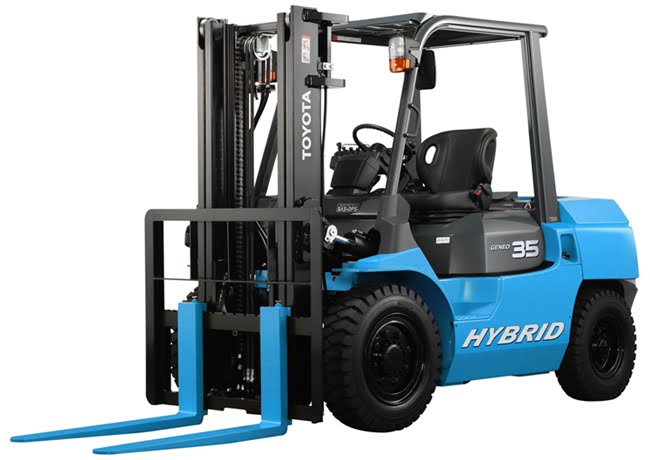Chapter 8: Emissions and Corporate Responsibility
This section of this document discusses the Corporate Responsibility of the company to its employees. By converting from fossil fuel vehicles to electrics, the pollutants employees breathe are eliminated. While emission controls on fossil fuel vehicles have made tremendous progress in the past decade, electric vehicles emit zero hazardous pollutants to the employees driving those trucks. While reduction is good, elimination is better.
A serious drawback to the use of internal combustion lift trucks in indoor material handling environments is the presence of polluting engine emissions: carbon monoxide (CO), various compounds of nitrogen and oxygen that contribute to creation of smog (lumped under the umbrella term NOx), hydrocarbons of various kinds (HCs), as well as particulates, soot and odors (See Fig. 4). Carbon monoxide (CO) is poisonous to humans. Nitrogen oxide (NOx) emissions are undesirable since they are considered greenhouse gases and thought to harm the ozone layer, contribute to the formation of acid rain and even to aggravate asthmatic conditions. Produced primarily from the combustion of fossil fuels, at least six oxides of nitrogen exist. Many of the emissions reduction initiatives today are directed at reducing NOx compounds, because of their impact on the environment.
The main approach to suppressing pollutants on IC lift trucks is the use of a catalytic converter. However, often-times a fix to the problems of modern technology does not come cheap, and catalytic converters are no exception. They are an expensive add-on to a lift truck and take up valuable space inside the lift truck chassis. What’s more, although LPG lift trucks equipped with a three-way catalytic converter do have lower NOx emissions, the problem is never eliminated completely unless electric lift trucks are used instead. Also, three-way catalytic converters only work effectively to reduce NOx emissions from LPG and fuel-gas engines.
If the engine emissions of a lift truck running on LPG are measured, the carbon monoxide (CO) content will be found to be only about 10 percent of that for automobiles or fuel-gas vehicles – including lift trucks. For that reason, internal combustion lift trucks used indoors are generally electric of LPG powered. Even if an IC lift truck meets or exceeds the exhaust emissions regulations in force, it will still pollute the air to some degree, even if only a small one. ”Excluding gasoline vehicles, the IC lift trucks considered the worst polluters when not fitted with a catalytic converter are those based on LPG technology. However, that is no longer true once a three-way catalytic converter is used. Running at full power (as opposed to idle engine speeds), an LPG lift truck with a three-way converter will exhaust significantly less CO than not fitted with a three-way catalytic converter, however, still 100% more than electric lit trucks, which have zero emissions.
The above table provides a general comparison of IC lift trucks to AC Electric lift trucks. When we add up the cost savings, reduced impact on the environment through lower carbon footprints and elimination of pollutants breathed by employees the justification to use electric lift trucks has never been stronger.
Notes:
- With all of the emissions reduction initiatives on IC trucks, vehicles of this type need even more complicated diagnostics and sensing components.
- This table uses fuel gas/LPG as the basis for comparison.
Continue to Final Conclusions…
Read The Full Series:
Chapter 1: The Concept of Total Cost of Ownership (TCO)
Chapter 2: AC Technology Compared to Internal Combustion
Chapter 3: Compressed Natural Gas (CNG)
Chapter 4: Trends in Materials Handling
Chapter 5: Voltage Levels Used in Electric Lift trucks Today
Chapter 6: Battery and Charging Systems
Chapter 7: Electric Braking and Energy Regeneration
Chapter 8: Emissions and Corporate Responsibility: A Major Problem for IC Lift Trucks
HCO Innovations is publishing this eight-part series as an in-depth comparative analysis and discussion on Compressed Natural Gas (CNG) Internal Combustion (IC) motors and Alternating Current (AC) Eletric lift truck engines, Comparison Analysis of CNG (IC) vs. AC Electric Lift Trucks, by Will Van Ness, VP of Fleet Management at HCO Innovations.
Comparison Analysis of CNG (IC) vs. AC Electric Lift Trucks (AC)
The materials handling industry continues to evolve at a rapid pace, particularly in the area of motive power propulsion. Tremendous technological advancements have been made over the past decade to directly address the rising cost of petrol (fossil fuels) along with stricter emission standards. Today’s MHE acquirers have more choices than ever when it comes to motive power propulsion and with the success seen amongst fleets utilizing alternative fuel sources such as lithium ion (LION) and Hydrogen Fuel Cell (HFC), the choices will most likely increase as time goes on. For the purpose of this discussion document, our focus will be on comparing AC Electric (AC) to Internal Combustion powered lift trucks (IC), specifically compressed natural gas (CNG).


